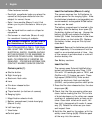
10 English
Service
Before returning a camera for service, con-
tact the Polaroid Customer Care Center or
the nearest Polaroid Office for shipping and
service information. The camera should be
packed in its original shipping carton or
other sturdy container, and shipped, pre-
paid and insured, to the nearest Polaroid
Office.
Battery Cautions (Macro 5 only)
• The batteries used in this device may
present a risk of one or more of the follow-
ing occurrences: Release of toxic materi-
als, release of flammable vapors, rise in
surface temperature. Do not recharge,
incinerate or mutilate.
• Replace batteries with the same type. Use
of another battery type may present a risk
of fire or explosion
• Dispose of used batteries promptly. Keep
away from children. Do not disassemble
and do not dispose of in fire. The cell may
explode. Check with local codes for possi-
ble special disposal instructions.
• When replacing batteries, replace all at the
same time. Mixing fresh and discharged
batteries could increase internal cell pres-
sure and rupture the discharged batteries.
Radio and television interference
FCC requirements
This device complies with Part 15 of the
FCC rules. Operation is subject to the fol-
lowing two conditions:
1 This device may not cause harmful interfer-
ence.
2 This device must accept any interference
received, including interference that may
cause undesired operation.
FCC Notice (U.S.A. only)
Warning: Changes or modifications to this
unit not expressly approved by the party
responsible for compliance could void the
user’s authority to operate the equipment.
This equipment has been tested and found
to comply with the limits for a Class B digi-
tal device, pursuant to Part 15 of the FCC
Rules. These limits are designed to provide
reasonable protection against harmful
interference in a residential installation.
This equipment generates, uses and can
radiate radio frequency energy and, if not
installed and used in accordance with the
instructions, may cause harmful interfer-
ence to radio communications. However,
there is no guarantee that interference will
not occur in a particular installation. If this
equipment does cause harmful interference
to radio or television reception, which can
be determined by turning the equipment
off and on, the user is encouraged to try to
correct the interference by one or more of
the following measures:
• Reorient or relocate the receiving antenna.
• Increase the separation between the equip-
ment and receiver.
• Consult the dealer or an experienced radio/
TV technician for help.
EMI Notice (Canada)
This digital apparatus does not exceed the
Class B limits for radio noise emissions
from digital apparatus set out in the Radio
Interference Regulations of the Canadian
Department of Communications.














